ECU HONDA ELEMENT 2010 1.G Owners Manual
[x] Cancel search | Manufacturer: HONDA, Model Year: 2010, Model line: ELEMENT, Model: HONDA ELEMENT 2010 1.GPages: 342, PDF Size: 5.76 MB
Page 30 of 342
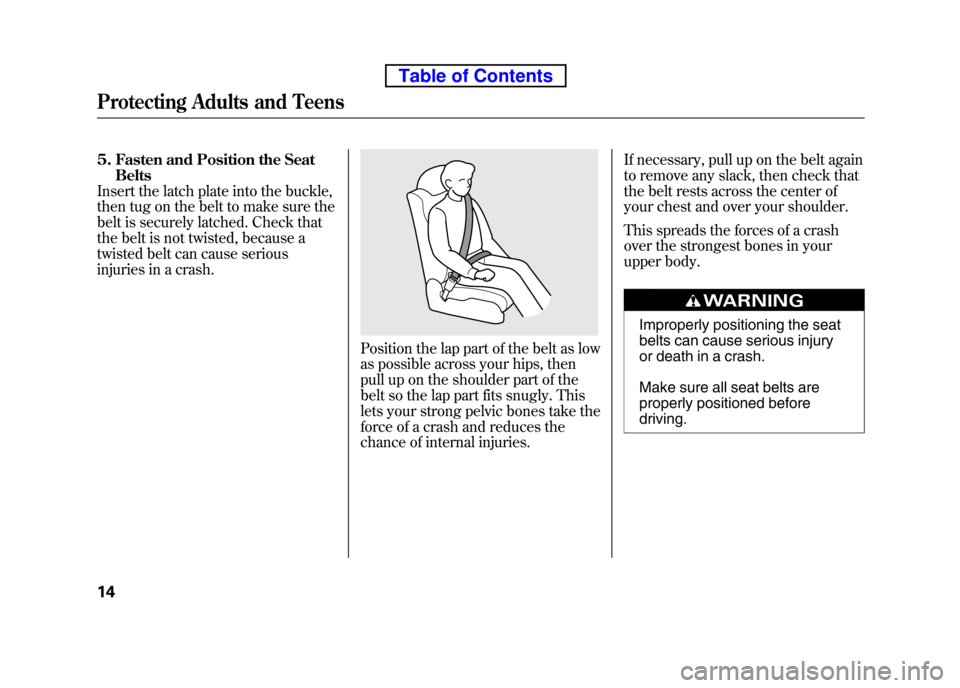
5. Fasten and Position the SeatBelts
Insert the latch plate into the buckle,
then tug on the belt to make sure the
belt is securely latched. Check that
the belt is not twisted, because a
twisted belt can cause serious
injuries in a crash.
Position the lap part of the belt as low
as possible across your hips, then
pull up on the shoulder part of the
belt so the lap part fits snugly. This
lets your strong pelvic bones take the
force of a crash and reduces the
chance of internal injuries. If necessary, pull up on the belt again
to remove any slack, then check that
the belt rests across the center of
your chest and over your shoulder.
This spreads the forces of a crash
over the strongest bones in your
upper body.
Improperly positioning the seat
belts can cause serious injury
or death in a crash.
Make sure all seat belts are
properly positioned beforedriving.
Protecting Adults and Teens
14
Table of Contents
Page 35 of 342
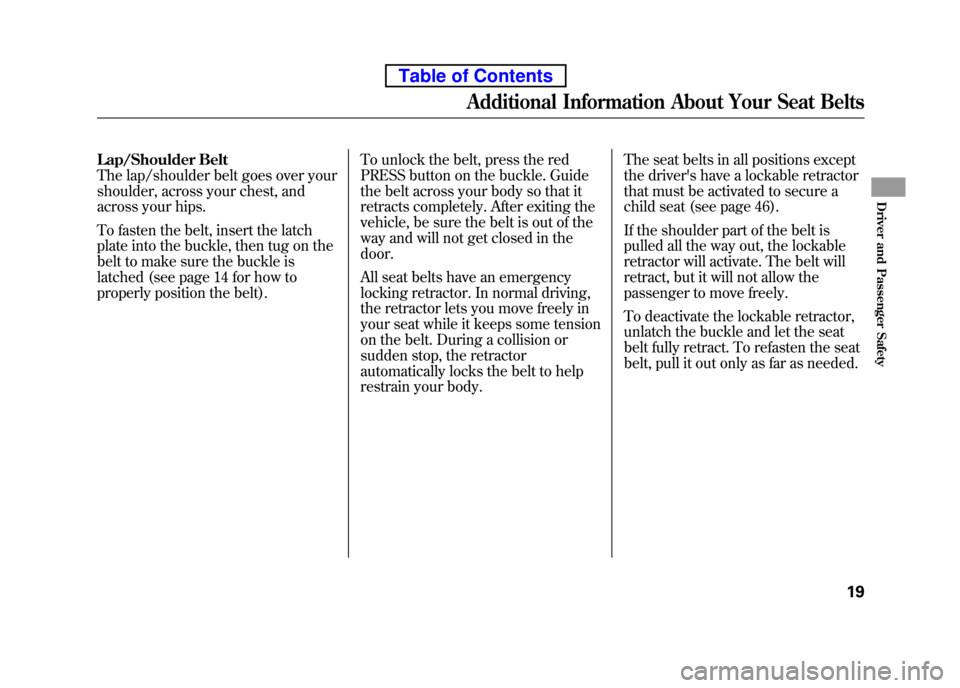
Lap/Shoulder Belt
The lap/shoulder belt goes over your
shoulder, across your chest, and
across your hips.
To fasten the belt, insert the latch
plate into the buckle, then tug on the
belt to make sure the buckle is
latched (see page 14 for how to
properly position the belt).To unlock the belt, press the red
PRESS button on the buckle. Guide
the belt across your body so that it
retracts completely. After exiting the
vehicle, be sure the belt is out of the
way and will not get closed in thedoor.
All seat belts have an emergency
locking retractor. In normal driving,
the retractor lets you move freely in
your seat while it keeps some tension
on the belt. During a collision or
sudden stop, the retractor
automatically locks the belt to help
restrain your body.The seat belts in all positions except
the driver's have a lockable retractor
that must be activated to secure a
child seat (see page 46).
If the shoulder part of the belt is
pulled all the way out, the lockable
retractor will activate. The belt will
retract, but it will not allow the
passenger to move freely.
To deactivate the lockable retractor,
unlatch the buckle and let the seat
belt fully retract. To refasten the seat
belt, pull it out only as far as needed.
Additional Information About Your Seat Belts
19
Driver and Passenger Safety
Table of Contents
Page 51 of 342
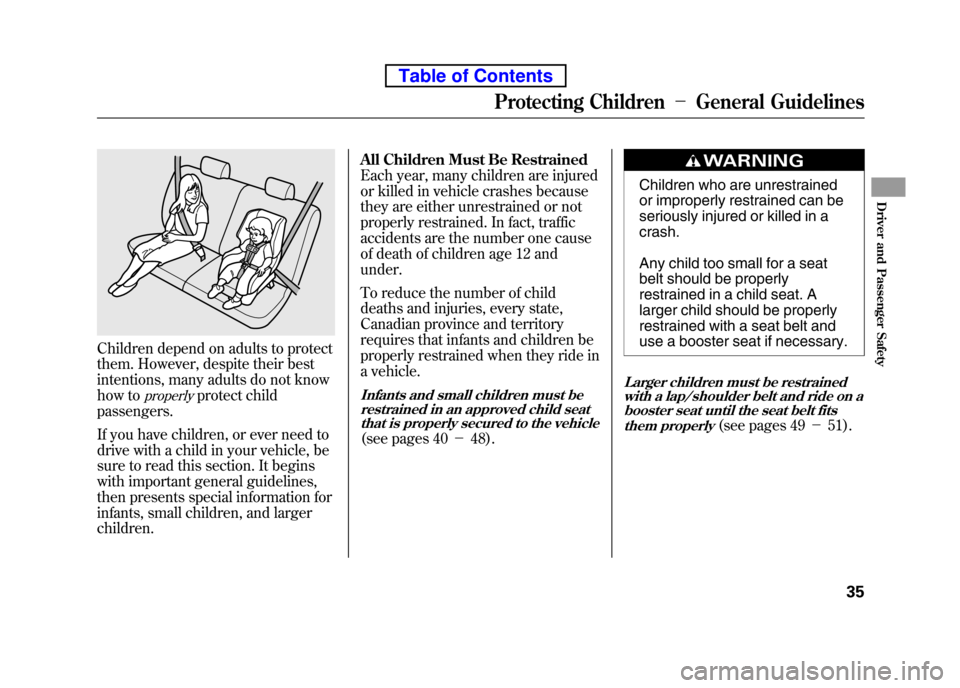
Children depend on adults to protect
them. However, despite their best
intentions, many adults do not know
how to
properlyprotect child
passengers.
If you have children, or ever need to
drive with a child in your vehicle, be
sure to read this section. It begins
with important general guidelines,
then presents special information for
infants, small children, and largerchildren. All Children Must Be Restrained
Each year, many children are injured
or killed in vehicle crashes because
they are either unrestrained or not
properly restrained. In fact, traffic
accidents are the number one cause
of death of children age 12 andunder.
To reduce the number of child
deaths and injuries, every state,
Canadian province and territory
requires that infants and children be
properly restrained when they ride in
a vehicle.Infants and small children must be
restrained in an approved child seatthat is properly secured to the vehicle
(see pages 40 -48).
Children who are unrestrained
or improperly restrained can be
seriously injured or killed in a crash.
Any child too small for a seat
belt should be properly
restrained in a child seat. A
larger child should be properly
restrained with a seat belt and
use a booster seat if necessary.
Larger children must be restrained
with a lap/shoulder belt and ride on a
booster seat until the seat belt fits
them properly
(see pages 49 -51).
Protecting Children -General Guidelines
35
Driver and Passenger Safety
Table of Contents
Page 54 of 342
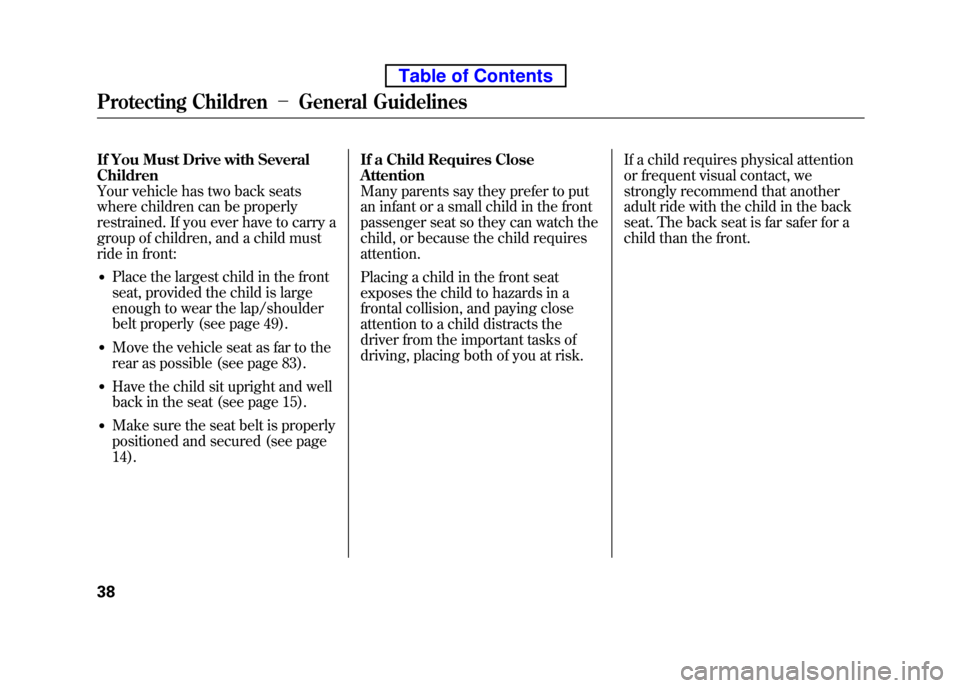
If You Must Drive with Several Children
Your vehicle has two back seats
where children can be properly
restrained. If you ever have to carry a
group of children, and a child must
ride in front:● Place the largest child in the front
seat, provided the child is large
enough to wear the lap/shoulder
belt properly (see page 49).
● Move the vehicle seat as far to the
rear as possible (see page 83).
● Have the child sit upright and well
back in the seat (see page 15).
● Make sure the seat belt is properly
positioned and secured (see page14). If a Child Requires CloseAttention
Many parents say they prefer to put
an infant or a small child in the front
passenger seat so they can watch the
child, or because the child requiresattention.
Placing a child in the front seat
exposes the child to hazards in a
frontal collision, and paying close
attention to a child distracts the
driver from the important tasks of
driving, placing both of you at risk.
If a child requires physical attention
or frequent visual contact, we
strongly recommend that another
adult ride with the child in the back
seat. The back seat is far safer for a
child than the front.
Protecting Children
-General Guidelines
38
Table of Contents
Page 58 of 342
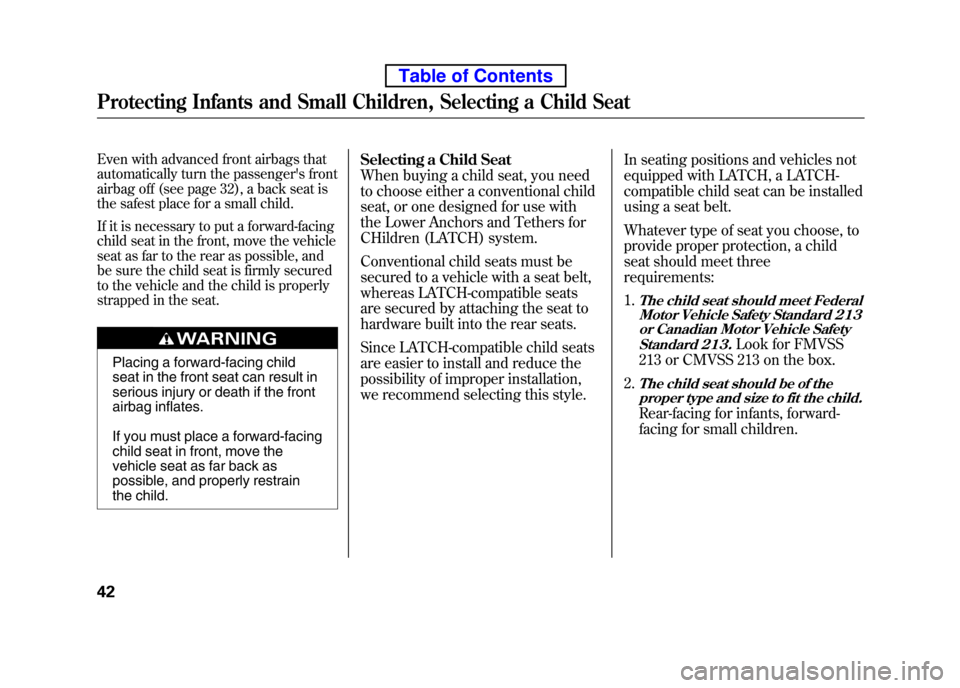
Even with advanced front airbags that
automatically turn the passenger's front
airbag off (see page 32), a back seat is
the safest place for a small child.
If it is necessary to put a forward-facing
child seat in the front, move the vehicle
seat as far to the rear as possible, and
be sure the child seat is firmly secured
to the vehicle and the child is properly
strapped in the seat.
Placing a forward-facing child
seat in the front seat can result in
serious injury or death if the front
airbag inflates.
If you must place a forward-facing
child seat in front, move the
vehicle seat as far back as
possible, and properly restrain
the child.Selecting a Child Seat
When buying a child seat, you need
to choose either a conventional child
seat, or one designed for use with
the Lower Anchors and Tethers for
CHildren (LATCH) system.
Conventional child seats must be
secured to a vehicle with a seat belt,
whereas LATCH-compatible seats
are secured by attaching the seat to
hardware built into the rear seats.
Since LATCH-compatible child seats
are easier to install and reduce the
possibility of improper installation,
we recommend selecting this style.
In seating positions and vehicles not
equipped with LATCH, a LATCH-
compatible child seat can be installed
using a seat belt.
Whatever type of seat you choose, to
provide proper protection, a child
seat should meet threerequirements: 1.
The child seat should meet Federal
Motor Vehicle Safety Standard 213or Canadian Motor Vehicle Safety
Standard 213.
Look for FMVSS
213 or CMVSS 213 on the box.
2.
The child seat should be of the proper type and size to fit the child.
Rear-facing for infants, forward-
facing for small children.
Protecting Infants and Small Children, Selecting a Child Seat
42
Table of Contents
Page 59 of 342
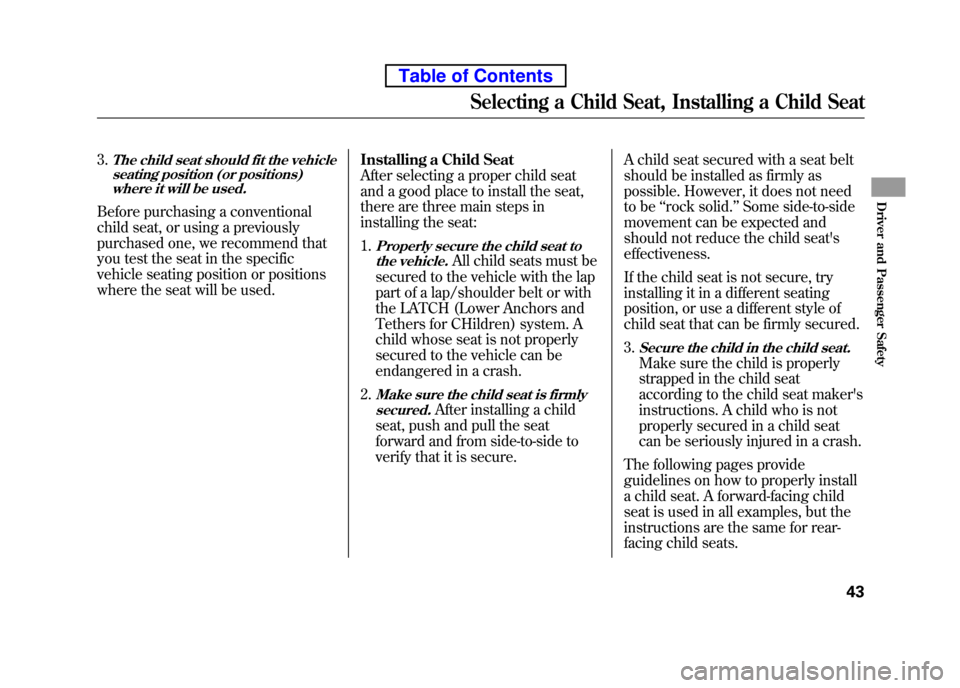
3.The child seat should fit the vehicleseating position (or positions)where it will be used.
Before purchasing a conventional
child seat, or using a previously
purchased one, we recommend that
you test the seat in the specific
vehicle seating position or positions
where the seat will be used. Installing a Child Seat
After selecting a proper child seat
and a good place to install the seat,
there are three main steps in
installing the seat: 1.
Properly secure the child seat to
the vehicle.All child seats must be
secured to the vehicle with the lap
part of a lap/shoulder belt or with
the LATCH (Lower Anchors and
Tethers for CHildren) system. A
child whose seat is not properly
secured to the vehicle can be
endangered in a crash.
2.
Make sure the child seat is firmly secured.
After installing a child
seat, push and pull the seat
forward and from side-to-side to
verify that it is secure. A child seat secured with a seat belt
should be installed as firmly as
possible. However, it does not need
to be
‘‘rock solid. ’’Some side-to-side
movement can be expected and
should not reduce the child seat'seffectiveness.
If the child seat is not secure, try
installing it in a different seating
position, or use a different style of
child seat that can be firmly secured. 3.
Secure the child in the child seat.
Make sure the child is properly
strapped in the child seat
according to the child seat maker's
instructions. A child who is not
properly secured in a child seat
can be seriously injured in a crash.
The following pages provide
guidelines on how to properly install
a child seat. A forward-facing child
seat is used in all examples, but the
instructions are the same for rear-
facing child seats.
Selecting a Child Seat, Installing a Child Seat
43
Driver and Passenger Safety
Table of Contents
Page 60 of 342
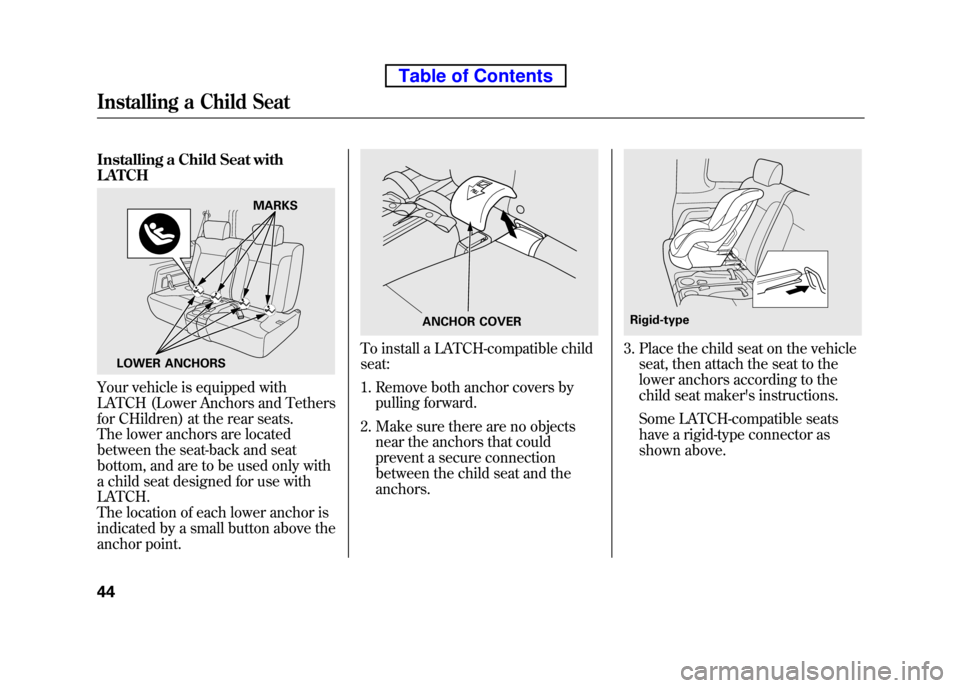
Installing a Child Seat with LATCH
Your vehicle is equipped with
LATCH (Lower Anchors and Tethers
for CHildren) at the rear seats.
The lower anchors are located
between the seat-back and seat
bottom, and are to be used only with
a child seat designed for use withLATCH.
The location of each lower anchor is
indicated by a small button above the
anchor point.
To install a LATCH-compatible child seat:
1. Remove both anchor covers bypulling forward.
2. Make sure there are no objects near the anchors that could
prevent a secure connection
between the child seat and theanchors.3. Place the child seat on the vehicleseat, then attach the seat to the
lower anchors according to the
child seat maker's instructions.
Some LATCH-compatible seats
have a rigid-type connector as
shown above.
MARKS
LOWER ANCHORS
ANCHOR COVERRigid-type
Installing a Child Seat
44
Table of Contents
Page 61 of 342
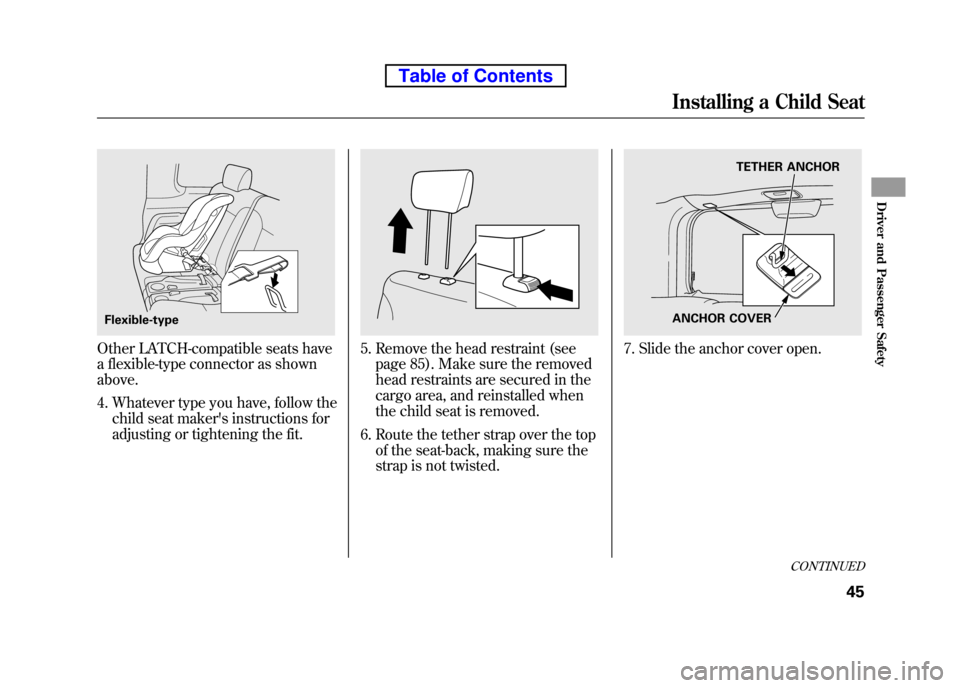
Other LATCH-compatible seats have
a flexible-type connector as shownabove.4. Whatever type you have, follow the child seat maker's instructions for
adjusting or tightening the fit.5. Remove the head restraint (seepage 85). Make sure the removed
head restraints are secured in the
cargo area, and reinstalled when
the child seat is removed.
6. Route the tether strap over the top of the seat-back, making sure the
strap is not twisted.7. Slide the anchor cover open.
Flexible-typeANCHOR COVER TETHER ANCHOR
CONTINUED
Installing a Child Seat
45
Driver and Passenger Safety
Table of Contents
Page 62 of 342
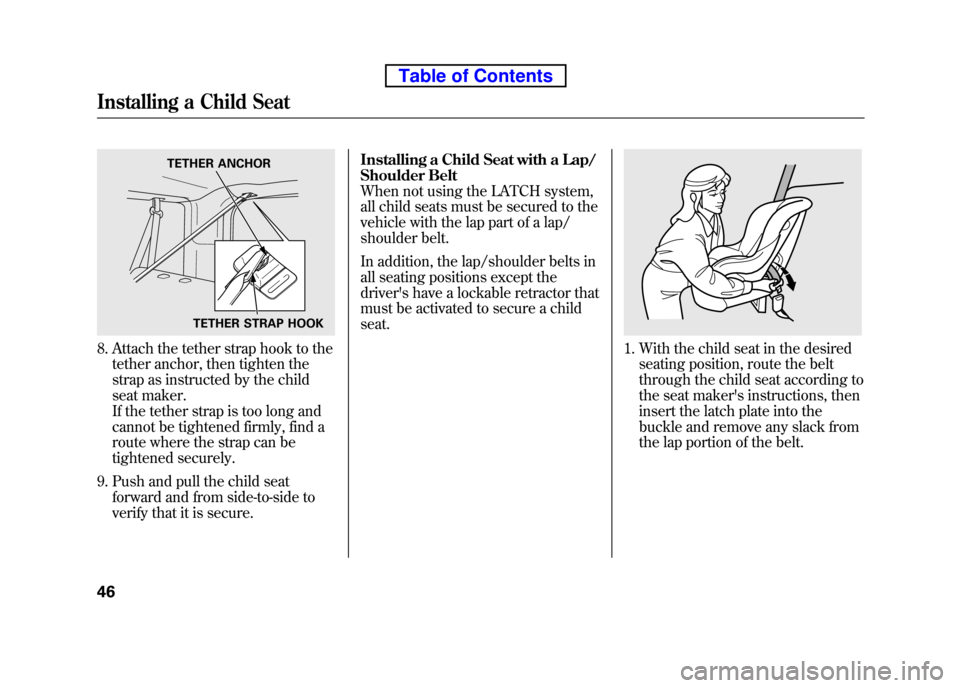
8. Attach the tether strap hook to thetether anchor, then tighten the
strap as instructed by the child
seat maker.
If the tether strap is too long and
cannot be tightened firmly, find a
route where the strap can be
tightened securely.
9. Push and pull the child seat forward and from side-to-side to
verify that it is secure. Installing a Child Seat with a Lap/
Shoulder Belt
When not using the LATCH system,
all child seats must be secured to the
vehicle with the lap part of a lap/
shoulder belt.
In addition, the lap/shoulder belts in
all seating positions except the
driver's have a lockable retractor that
must be activated to secure a childseat.1. With the child seat in the desired
seating position, route the belt
through the child seat according to
the seat maker's instructions, then
insert the latch plate into the
buckle and remove any slack from
the lap portion of the belt.
TETHER STRAP HOOK
TETHER ANCHOR
Installing a Child Seat
46
Table of Contents
Page 63 of 342
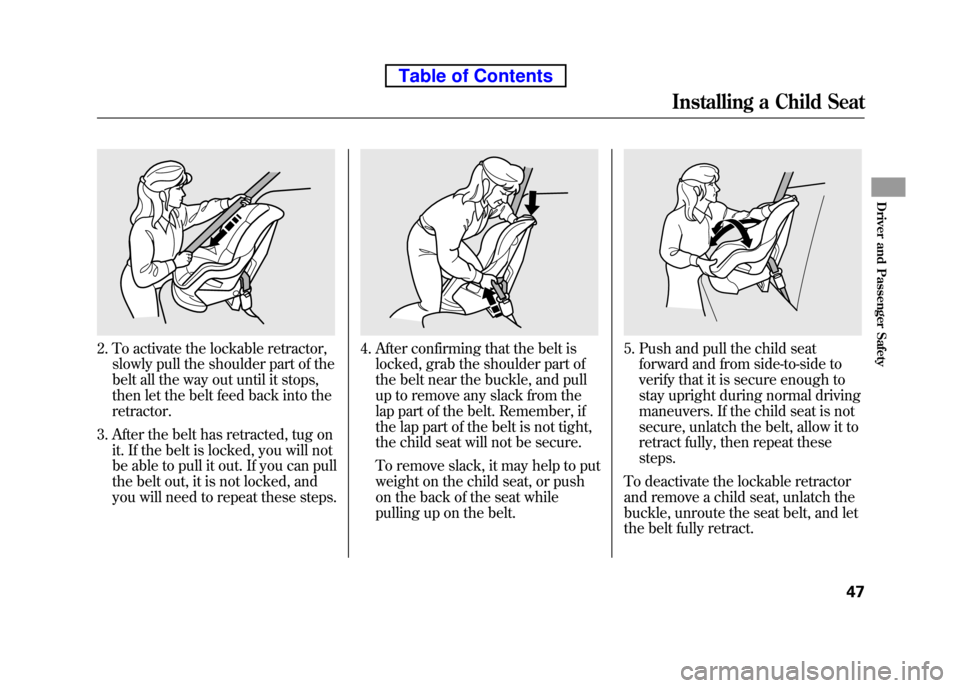
2. To activate the lockable retractor,slowly pull the shoulder part of the
belt all the way out until it stops,
then let the belt feed back into theretractor.
3. After the belt has retracted, tug on it. If the belt is locked, you will not
be able to pull it out. If you can pull
the belt out, it is not locked, and
you will need to repeat these steps.4. After confirming that the belt islocked, grab the shoulder part of
the belt near the buckle, and pull
up to remove any slack from the
lap part of the belt. Remember, if
the lap part of the belt is not tight,
the child seat will not be secure.
To remove slack, it may help to put
weight on the child seat, or push
on the back of the seat while
pulling up on the belt.5. Push and pull the child seatforward and from side-to-side to
verify that it is secure enough to
stay upright during normal driving
maneuvers. If the child seat is not
secure, unlatch the belt, allow it to
retract fully, then repeat thesesteps.
To deactivate the lockable retractor
and remove a child seat, unlatch the
buckle, unroute the seat belt, and let
the belt fully retract.
Installing a Child Seat
47
Driver and Passenger Safety
Table of Contents